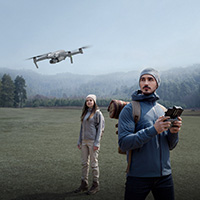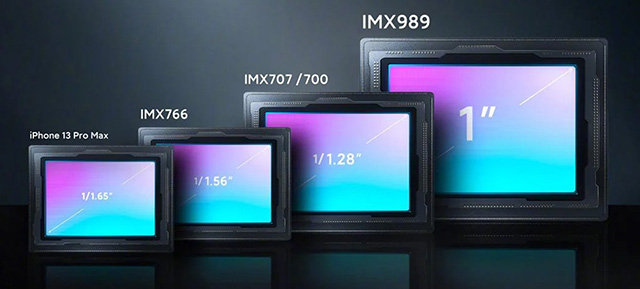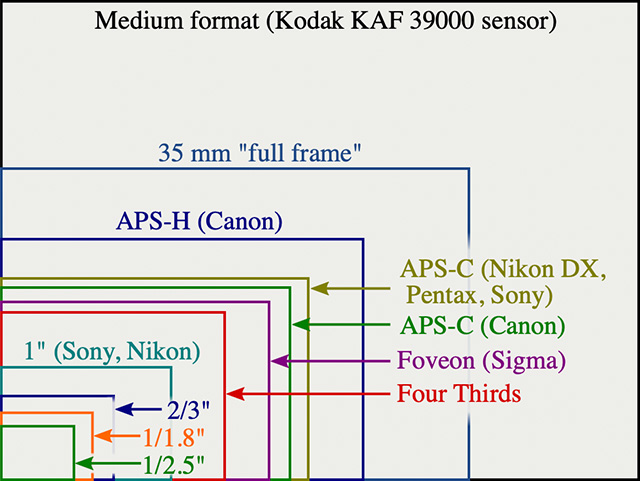Sensor size versus format: Dealing with the confusing and misleading “1-inch-type” image sensor
posted Thursday, July 28, 2022 at 10:54 AM EDT

A 1"-type sensor must be an inch, right? It would make sense. However, as surely some of you know, a 1-inch sensor is considerably smaller than an inch. It's confusing and odd. If the name of a sensor includes a unit of measurement, why is the measurement not accurate? To overcome this confusion, we will change our naming system style guide to "Type 1 (sensor dimensions)." This will make it immediately clear what the actual sensor area is when discussing the smaller "1-inch type" image sensors found in many smartphones, drones, and compact cameras.
The history of the "1-inch sensor"
The odd naming convention goes back to the dimensions of a hypothetical glass tube that could surround the 1-inch sensor. Live broadcasting cameras in the 1950s used cathode-ray tubes (CRT) to project an image line after line. The glass tube that surrounded a signal plate had a 1-inch diameter, although the photosensitive area of the tube was only about 0.63" in diameter – or around 16mm. The typical diagonal of a modern 1-inch type sensor is, you guessed it, 16mm (15.9mm, to be precise).
After all this time, and despite using wildly different technology than CRT broadcasting cameras in the 1950s, the 1-inch nomenclature has remained. The photosensitive area in question wasn't an inch in diameter back then, and it still isn't now. Modern 1-inch sensors refer to a hypothetical CRT tube that would be an inch in diameter to theoretically fit around a 1-inch type image sensor.

It's confusing. The image sensor "format" is not the same as its size. That inconsistency by itself isn't confusing – medium-format doesn't refer to the image sensor size – but it is confusing when the sensor format relies upon an inaccurate unit of measurement in its name. If you didn't know the origin of the term "1-inch type sensor," you'd reasonably conclude that a 1-inch-type sensor is an inch wide or an inch in diagonal.
Why is the typical naming convention problematic?
Is it an outright lie when manufacturers make claims like "our smartphone is the first to include a 1-inch sensor," or "our drone uses a large 1-inch image sensor?" Not exactly, but at the very least, it's misleading and confusing. For this reason, Sony Semiconductor, one of the world's premiere sensor makers, has already changed its naming system.
What we're doing about it
We want to help reduce the confusion and make it easier for prospective customers to understand what they're buying. Alongside DPReview, PetaPixel, Cameralabs, Gerald Undone, The Art of Photography and potentially more publications and YouTube channels, we will adopt a new naming system that better conveys the physical sensor size of what are often referred to as 1-inch type sensors. The physical size of an image sensor has a real, sometimes significant, effect on image quality. We want readers to better understand the sensor size of a product without needing to get into the weeds on the history of CRT broadcast cameras and hypothetical glass tubes.

Moving forward, we will refer to typical 1-inch type sensors as Type 1 (12.7 x 9.5mm). For even smaller image sensors, we'll refer to those in a similar format, writing out Type 1/X (approximate sensor dimensions). While we could refer to larger image sensors similarly – full-frame cameras would be Type 2.7, for example – there's no need, as those sensor formats are well-understood and sensible. Nothing is misleading about "full frame." There is possible confusion with medium-format cameras since medium-format sensors come in a couple of sizes (44 x 33mm and 53.4 x 40mm), but we always make a point to note sensor size when reviewing medium-format cameras, like the Fujifilm GFX 100S (44 x 33mm) and Phase One IQ4 150MP (53.4 x 40mm).
While compact cameras with small sensors are becoming rarer, there are still many popular cameras with Type 1 image sensors, like the Sony RX100 Mark VII. Where we most often see small sensors are with new smartphones and drones. We hope the change to "Type 1 (sensor dimensions) sensor" will make it easier to understand the sensor size for these new products and help readers make more informed decisions about what they'd like to purchase. While there's no doubt that you can capture amazing images with small image sensors, sensor size does matter.
Our database will be updated to reflect this change later down the road, but we will employ the new naming system from today.

